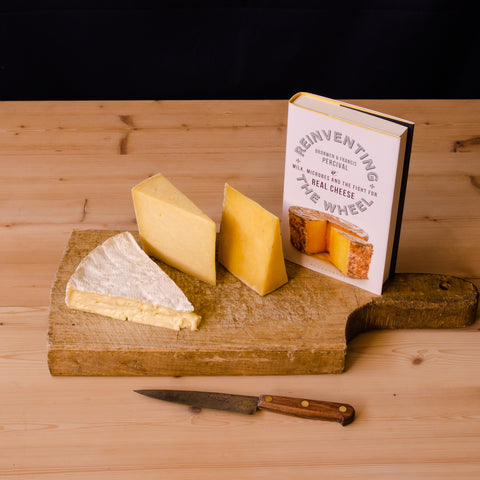Science of Artisan Cheese Conference 2022
The Science of Artisan Cheese Conference is back in person this year and will bring the cheese community together with experts in fermentation, microbiology, cheesemaking and farming. The conference is organised by Neal's Yard Dairy's Buying and Technical Manager Bronwen Percival who also wrote Reinventing the Wheel; a book which tells the life of a cheese, from the grasses and animals, to the role of microbes and the cheesemaking process, to the cheesemaker. To give you a flavour of the topics discussed at the conference, we've created the Reinventing the Wheel Selection which includes a copy of the book with some of cheeses that feature in it.

Reinventing the Wheel Selection
The guestlist for the Science of Artisan Cheese conference in 2012 read like a Who’s Who of artisan cheese: Harold McGee, Benjamin Wolfe, Joe Schneider, Jamie Montgomery and of course Randolph Hodgson: Neal’s Yard Dairy founder and the originator of this inaugural gathering of cheesemakers, affineurs and world experts in fermentation and microbiology. The conference has taken place every other year since – remotely of course, during the pandemic – and unites those at the forefront of microbiological science with those at the forefront of artisan cheese and, increasingly, farming. At its most basic, says Bronwen Percival of Neal’s Yard Dairy, it’s a long and continuous conversation, initially sparked by a chance encounter between Randolph and a French microbiologist in the Auvergne region of central France.
“She was looking at the diverse communities of natural microbes in raw milk, and how they could have a protective effect on the cheese. Speaking to her, Randolph thought it would be amazing if they continue the conversation over here with cheesemakers. He mentioned it to me and I thought it sounded interesting – so I invited her and a large number of people who are working in cheese on an artisan scale.”
That first conference focused on the importance of diverse microbial communities in raw milk, on safety around raw milk, and on cheese rinds. Harold McGee was the keynote speaker and microbiologist Benjamin Wolfe gave a presentation on his work with different cheese rinds from around the world. “He and Rachel Dutton worked in Harvard using cheese rinds as a system for modelling microbial reactions,” Bronwen enthuses. “He is the best science communicator I have met in whole life.” You can get a taste of Benjamin’s extraordinary communication skills here. It kicked off in Cadbury Court, ancestral home of cheesemaker Jamie Montgomery and his historic and world-famous Montgomery Cheddar cheese. “It was the perfect environment for getting 100 people together, sharing information and networking. There was so much positivity,” Bronwen recalls. “It made sense to continue the conversation on alternate years to the Bra cheese festival so that there’s a big gathering of the community every year.”
Fast forward 10 years, and that community is looking forward to its fifth in-person conference: once again curated by Bronwen, once again hosted by Jamie. Yet the world in general, and the world of artisan cheese specifically, have changed significantly in the intervening decade. Where once the conference concentrated solely on microbiological diversity in raw milk and cheese, now the conversation has spread out to encompass plant and animal diversity and the environment. “What does farming for good raw milk look like? What role does environmental diversity play in that? Can artisan cheese save rare breeds? What does net-zero dairy look like?” says Bronwen. “If there is a theme for 2022, I’d say it’s looking at what good, progressive farming is for cheese.”
These are big, complex questions; questions that both necessitate and thrive off the bandying around of ideas and experiences which occurs at this conference. Key for Bronwen this year will be separating fact from fiction when it comes to sequestering carbon in the soil on dairy farms, a topic that has generated a lot of noise in recent years among farmers and environmentalist, but not always the degree of nuance it needs. Then there’s the domestication of cheese fungi, which also benefits from nuance and challenging past assumptions. “We tend to think of mould as something that is good when grown on artisan cheese, but bad when grown on bread, but there’s accumulating evidence that, just like animals, moulds are yeasts which undergo domestication when cultivated and grown within the cheese environment. So we have a researcher from France coming to talk about Geotrichum, everyone’s favourite cheese mould, and the team from a lab in Nottingham are going to show us a selection of new moulds that they’re breeding for use in blue cheese.”
This combination of new blue cheese and carbon sequestration points exactly to the sort of balance the conference strikes between excitement, interest and urgent challenges. A talk and a farm tour with a dung beetle specialist promise to offer some light relief, yet the current bout of tuberculosis sweeping farms in the UK will be the subject of much discussion – particularly the possibility of a vaccine against bovine TB, which is currently the subject of field trials and which Bronwen believes is the only way the problem will be solved.
There aren’t always tangible outcomes. Progress is often iterative. “It’s not designed to solve problems overnight, but it’s a way of showing producers how scientific progress takes place, what form it takes, and creating a relationship so that scientists can look at things with practical implications.” If that sounds wishy-washy, it’s because it is, says Bronwen – kind of. “It’s a wish-washy way of going about it, but it needs to be. It’s not about generating outcomes specifically. It’s about creating a space and bringing people together, and from that all sorts of things can come that can change things in the long term.”
One compelling example of this is the Raw Drinking Milk Association, an idea seeded by Bronwen and Jonny Crickmore of Fen Farm Dairy, but brought to fruition when artisan cheese expert Jennifer Kast met Anna Catharina ‘Cat’ Berge at a seminar in Sweden. “Cat is a raw milk drinking specialist; a triathlon runner, who came to the conference at around the same time when the Raw Drinking Milk Association was just an idea. She came and talked about how having a heathy farm environment and healthy animals was a prerequisite for good milk. She talked about reducing antibiotic usage and biosecurity.” She didn’t specifically talk about raw drinking milk, Bronwen continues, but bringing her to the conference helped the idea for an association of raw milk producers take shape and gain momentum.”
It is easy to romanticise the artisan cheese world. There’s a lot that’s romantic about it – but it is also like many other businesses in that it’s all too easy to get wrapped up in the demands and the drudgery of the day-to-day. What the Science of Artisan Cheese Conference offers is a chance for people from various parts of that world to come together, step back and take a long view,” says Bronwen, “to look at the macro and the long-term prospects, and to be exposed to new ideas – ideas which may sound utterly fantastic to everyone now but may be obvious in a few years’ time. It gives a sense of purpose,” she continues – a belief that is warmly echoed by Joe Schneider, a regular attendee and the cheesemaker best known for putting traditional raw milk blue cheese back on the culinary map with his cheese Stichelton.
“I love the conference because it embodies everything I am proud of in our specialist cheesemakers’ community: proactive engagement with our own technical and food safety challenges, in a collaborative way with our industry and its regulators,” he says. “That seems to be unique in the food world.”

